Honda CR-V: Radiator Cap Test
1. Remove the radiator cap (A), wet the seal with engine coolant, then install it on the pressure tester (B) (commercially available).
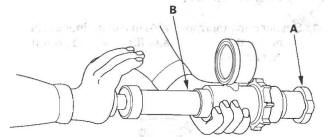
2. Apply a pressure of 93-123 kPa (0.95-1.25 kgf/cm2, 14-18 psi).
3. Check for a drop in pressure.
4. If the pressure drops, replace the cap.
Radiator Test
1. Wait until the engine is cool, then carefully remove the radiator cap and fill the radiator with engine coolant to the top of the filler neck.
2. Attach the pressure tester (A) (commercially available) to the radiator.
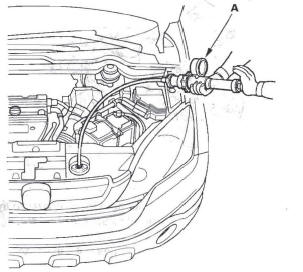
3. Apply a pressure of 93 - 123 kPa (0.95-1.25 kgf/cm2, 14 - 18 psi).
4. Inspect for engine coolant leaks, and a drop in pressure.
5. Remove the tester, and reinstall the radiator cap.
6. Check for engine oil in the coolant and/or coolant in the engine oil.
Fan Motor Test
1. Disconnect the 2P connectors from the radiator fan motor and condenser fan motor.
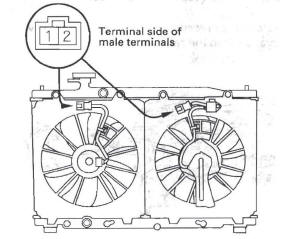
2. Test the motor by connecting battery power to the terminal No.2 and ground to the terminal No.1.
3. If the motor fails to run, or does not run smoothly, replace it.
Thermostat Test
Replace the thermostat if it is open at room temperature.
To test a closed thermostat:
1. Suspend the thermostat (A) in a container of water.
Do not let the thermometer (B) touch the bottom of the hot container.
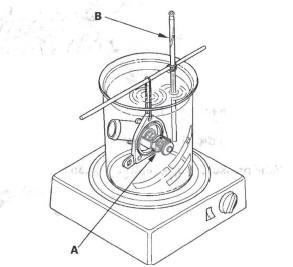
2. Heat the water, and check the temperature with a thermometer. Check the temperature where the thermostat first opens, and where it is fully open.
3. Measure the lift height of the thermostat when it is fully open.
Standard Thermostat
lift Height: Above 8.0 mm (0.31 in.)
Starts Opening: 169-176ºF (76 -80 ºC)
Fully Open: 194ºF (90 ºC)
Water Pump Inspection
1. Remove the drive belt.
2. Turn the water pump pulley counterclockwise.
Check that it turns freely. If it doesn't, replace the water pump.
NOTE: When you check the water pump, you may see a small amount of "weeping" from the bleed holes (A). This is normal.
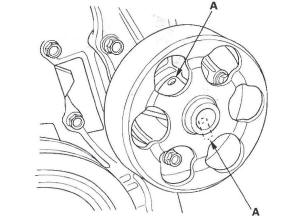
3. Install the drive belt.
Water Pump Replacement
1. Remove the drive belt.
2. Drain the engine coolant.
3. Remove the drive belt auto-tensioner pulley.
4. Remove the six bolts securing the water pump, then remove the water pump (A).
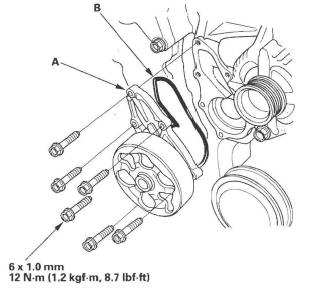
5. Inspect and clean the O-ring groove and mating surface with the water passage.
6. Install the water pump with new O-ring (B) in the reverse order of removal.
7. Clean up any spilled engine coolant.
8. Install the drive belt auto-tensioner pulley.
9. Refill the radiator with engine coolant, and bleed the air from the cooling system with the heater valve open (see step 6 ).
Coolant Check
1. Look at the coolant level in the coolant reservoir.
Make sure it is between the MAX mark (A) and MIN mark (B).
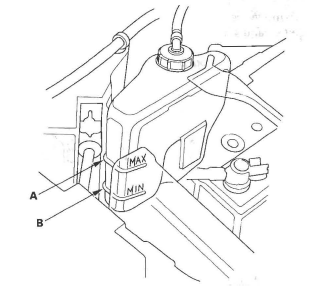
2. If the coolant level in the coolant reservoir is at or below the MIN mark, add coolant to bring it up to the MAX mark, and inspect the cooling system for leaks.
Coolant Replacement
1. Start the engine. Set the heater temperature control dial to maximum heat, then turn off the ignition switch. Make sure the engine and radiator are cool to the touch.
2. Remove the radiator cap.
3. Loosen the drain plug (A), and drain the coolant.
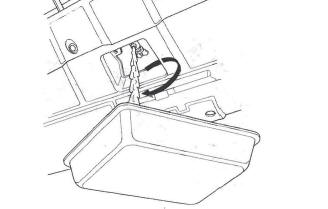
4. After the coolant has drained, tighten the radiator drain plug.
5. Remove the coolant reservoir, and drain the coolant, then reinstall the coolant reservoir.
6. Fill the coolant reservoir to the MAX mark (A) with Honda Long Life Antifreeze/Coolant Type 2 (P/N OL999-9001).

7. Pour Honda Long Life Antifreeze/Coolant Type 2 (P/N OL999-9001) into the radiator up to the base of the filler neck.
NOTE:
- Always use Honda Long Life Antifreeze/Coolant Type 2 (P/N OL999-9001). Using a non-Honda coolant can result in corrosion, causing the cooling system to malfunction or fail.
- Honda Long Life Antifreeze/Coolant Type 2 is a mixture of 50 % antifreeze and 50 % water. Do not add water.
Engine Coolant Capacities (Including the coolant reservoir capacity of 0.6 L (0.16 US gal) )
At Coolant Change:
5.0 L (1.32 US gal)
After Engine Overhaul:
7.1 L (1.88 US gal)
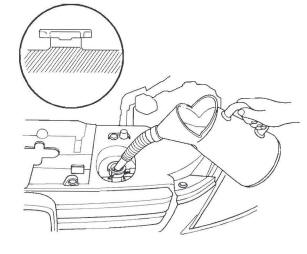
8. Loosely install the radiator cap.
9. Start the engine, and let it run until it warms up (the radiator fan comes on at least twice).
10. Turn off the engine. Check the level in the radiator and add Honda Long Life Antifreeze/Coolant Type 2 if needed.
11. Put the radiator cap on tightly, then run the engine again, and check for leaks.
12. Clean up any spilled engine coolant.
Thermostat Replacement
1. Drain the engine coolant.
2. Remove the splash shield (see step 21).
3. Remove the lower hose, then remove the thermostat.
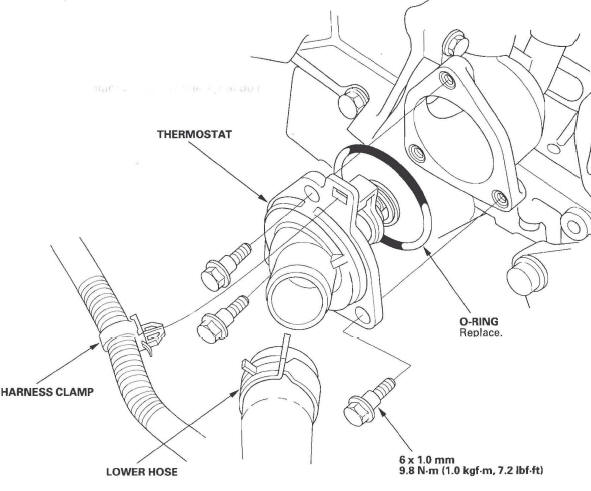
4. Install the thermostat with a new O-ring, then install the lower hose.
5. Install the splash shield (see step 34 ).
6. Refill the radiator with engine coolant, and bleed the air from the cooling system with the heater valve open (see step 6).

